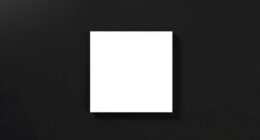In the modern workplace, attention is a limited and valuable resource that directly impacts your productivity, innovation, and decision-making. With constant distractions and fierce competition for focus, managing attention effectively becomes essential. Technologies can both help and hinder your focus, so adopting strategies like mindfulness and structured routines is key. Cultivating a culture that values deep work can markedly boost organizational success. Keep exploring to discover how attention truly drives workplace performance and growth.
Key Takeaways
- Attention is a limited and valuable resource, influencing productivity, decision-making, and innovation in the workplace.
- Distractions and interruptions incur high costs, reducing focus, efficiency, and mental clarity.
- Effective attention management strategies, like mindfulness and task prioritization, enhance organizational performance.
- Recognizing attention as an economic asset encourages environments that support sustained engagement and focus.
- Competition for employee attention increases with workplace distractions, necessitating deliberate efforts to capture and retain focus.
The Concept of Attention as an Economic Asset

Attention has become a valuable resource in today’s workplace because it directly influences productivity and decision-making. As a leader, practicing mindful leadership helps you manage your attention span effectively, setting an example for your team. When you focus intently on priorities, you maximize the quality of your decisions and improve overall efficiency. Recognizing attention as an economic asset means understanding that it’s limited and precious. By allocating your attention wisely—whether during meetings, strategic planning, or problem-solving—you create value for your organization. Employees are more engaged and productive when their leaders demonstrate control over their own attention. Ultimately, cultivating a disciplined attention span enhances your influence, drives better outcomes, and underscores attention’s role as a key resource in the modern workplace economy. Understanding the value of attention can also help you identify opportunities for *resource allocation* and optimize your overall performance.
Scarcity and Competition for Employee Attention

Your employees have limited attention resources, making it harder to focus amid constant distractions. As these risks increase, capturing their attention becomes more challenging and competitive. To succeed, you need effective engagement strategies that stand out in this crowded environment. Incorporating diversification strategies can help organizations better manage competing priorities and foster sustained engagement.
Limited Attention Resources
In today’s workplace, employees’ cognitive resources are limited, making attention a scarce commodity. With constant demands, your ability to focus depends on developing mindful awareness and attentional resilience. Recognizing these limits helps you prioritize tasks effectively. Here’s a quick look at how attention resources are distributed:
| Task Type | Cognitive Load | Priority Level |
|---|---|---|
| Routine Tasks | Low | Medium |
| Critical Projects | High | High |
| Interruptions | Variable | Often Low |
Balancing these demands requires awareness of your attention capacity. Cultivating mindful awareness allows you to recognize when your focus wanes, helping preserve your limited resources for high-priority work. Strengthening attentional resilience prepares you to handle fluctuating demands without burnout. Additionally, understanding the role of AI in Business can provide tools to optimize workflow and reduce unnecessary distractions.
Distraction Risks Increase
When multiple tasks and constant interruptions compete for your focus, the risk of distraction intensifies. You become more prone to multitasking fatigue, which hampers your efficiency and increases error rates. Emotional distraction also rises as you’re pulled into reactive responses to emails, messages, or workplace conflicts. The scarcity of your attention makes it harder to maintain deep focus, leading to fragmented work sessions. You might find yourself:
- Struggling to complete complex tasks due to frequent interruptions
- Feeling overwhelmed by the cumulative mental load of multitasking
- Experiencing emotional burnout from persistent distractions
As distractions multiply, your ability to sustain attention deteriorates, creating a cycle of reduced productivity and increased stress. Recognizing these risks is crucial to managing your attention effectively in a competitive, distraction-rich environment. Attention span is a limited resource that requires deliberate management to optimize performance.
Competitive Engagement Strategies
How do organizations effectively capture and sustain employee attention in a landscape saturated with competing demands? The key lies in employing competitive engagement strategies rooted in mindful leadership and emotional intelligence. By understanding what truly motivates employees, you can create scarce yet meaningful opportunities for focus, reducing information overload. Leaders who practice emotional intelligence recognize individual needs and tailor communication to resonate personally. This approach fosters trust and loyalty, making employees more receptive to engagement efforts. Using mindful leadership, you prioritize quality over quantity, emphasizing clarity and purpose in messaging. Scarcity becomes a tool—not through limiting access but by enhancing perceived value. Incorporating high-pressure techniques can further motivate employees by emphasizing urgency and importance. Ultimately, blending emotional intelligence with strategic scarcity helps cut through the noise, ensuring your organization captures and sustains attention effectively.
The Cost of Distraction in the Workplace

Have you ever noticed how a single distraction can derail your entire work session? That tiny interruption can lead to significant costs, especially when you fall into multitasking pitfalls or experience attention fatigue. Distractions fragment your focus, reducing productivity and increasing errors. Every time your attention shifts, it takes time to refocus, draining mental energy. The costs include missed deadlines, lower quality work, and heightened stress. You may also find yourself repeatedly rechecking tasks, leading to decreased efficiency. Over time, this constant disruption hampers your ability to concentrate and hampers overall performance. Recognizing these costs highlights the importance of managing distractions to preserve mental clarity and work quality. One effective strategy is understanding the role of contrast ratio in images, which can be analogous to managing visual distractions in your workspace to improve focus. Without control, distractions can quietly chip away at your productivity and well-being.
Strategies for Capturing and Retaining Focus

To combat the costs of distraction, adopting effective strategies to capture and maintain your focus is essential. Start by practicing mindful awareness—regularly check in with your thoughts and environment to identify when your attention drifts. Focus cultivation involves creating routines that enhance your ability to concentrate, such as setting clear goals and breaking tasks into manageable steps. Minimize interruptions by designating specific times for deep work and using physical cues or rituals to signal your focus periods. Take short breaks to reset your mind, preventing burnout and sustaining attention over longer periods. Incorporating insights from the *Best Vacuums for Dust Removal in 2024* can serve as a metaphor for thoroughness, emphasizing the importance of consistent and comprehensive focus. Developing these habits helps you stay present, increases productivity, and reduces the impact of distractions. Continuous focus cultivation ultimately enhances your efficiency and mental clarity throughout the workday.
The Role of Technology and Digital Tools

Technology and digital tools play a crucial role in shaping your ability to focus at work. They can enhance productivity but also create distractions that drain your attention. To manage this, implementing a digital detox helps you disconnect periodically, reducing overload. Incorporating mindfulness practices, like brief meditation breaks, sharpens your focus and reduces stress. Digital tools such as task managers streamline your workflow, minimizing unnecessary interruptions. You might also use apps that limit notifications, allowing sustained concentration. These strategies help you regain control over your attention, ensuring technology supports rather than sabotages your work focus. Balancing digital engagement with intentional breaks creates a healthier, more mindful work environment, making your attention a valuable resource rather than a commodity to be exploited.
Impact of Attention Management on Productivity

When you manage your attention effectively, you’ll notice a boost in your productivity. Distractions can slow you down, while staying focused helps you get more done in less time. Prioritizing tasks allows you to perform at your best and achieve your goals more efficiently. Incorporating mindfulness practices into your routine can further enhance your ability to stay present and attentive throughout the day.
Distractions Reduce Efficiency
Distractions in the workplace can substantially hinder your productivity by breaking your focus and reducing the time you spend on important tasks. When your attention is diverted, it takes longer to complete work, and errors become more likely. Without mindful awareness, you might react impulsively to constant interruptions, weakening your attentional resilience. This makes it harder to regain focus after each distraction. Common sources include notifications, chat messages, or noisy environments. Imagine trying to finish a report while a coworker’s phone rings repeatedly, or your email pops up unexpectedly. These interruptions chip away at your efficiency, causing stress and fatigue. Developing attentional resilience and practicing mindful awareness can help you better manage distractions, keeping your focus sharper and your work more effective. Understanding the importance of attention management can help you implement strategies to minimize distractions and improve overall productivity.
Focus Enhances Output
Managing your attention effectively allows you to produce higher quality work in less time. When you stay focused, your productivity increases, and errors decrease. Mindful leadership encourages teams to develop focus through focus training, sharpening collective attention. This discipline helps you avoid multitasking, which hampers efficiency. To illustrate, consider the table below:
| Skill | Benefit |
|---|---|
| Focus training | Boosts concentration |
| Mindful leadership | Cultivates disciplined focus |
| Deep work | Enhances output quality |
| Reduced distractions | Accelerates task completion |
| Consistent routines | Builds sustained attention |
Additionally, incorporating lifestyle for longevity strategies such as stress management and adequate sleep can further optimize your cognitive function and attention span.
Prioritization Boosts Performance
Prioritization is essential for maximizing your productivity because it directs your attention to high-impact tasks, ensuring you work efficiently. When you focus on what truly matters, you develop mindful awareness, helping you recognize distractions early. This sharpens your attentional resilience, making it easier to bounce back from interruptions. By intentionally ranking tasks, you create a clear path to success:
- Concentrate on tasks that align with your goals, reducing wasted effort
- Minimize distractions by focusing on one priority at a time
- Build mental resilience, maintaining focus despite workplace chaos
Prioritization allows you to harness your attention strategically, boosting performance and preventing burnout. When you manage your attention effectively, your productivity skyrockets, making every moment count.
Attention as a Driver of Innovation and Creativity

Attention plays a crucial role in fueling innovation and creativity in the workplace. When you practice mindful awareness, you become more attuned to subtle details and emerging ideas, opening the door for creative serendipity. By focusing your attention intentionally, you can connect disparate concepts and generate novel solutions. This heightened awareness allows you to recognize opportunities others might overlook, sparking breakthroughs. When your attention is fully present, you cultivate an environment where new ideas flourish and risk-taking feels more natural. Remember, sustained focus isn’t about rigidity; it’s about being open to unexpected insights. Embracing attentive engagement boosts your capacity to innovate, transforming ordinary tasks into fertile ground for creative discovery. Your conscious attention becomes a powerful engine for driving workplace innovation and originality.
Organizational Policies and Cultural Approaches

Organizational policies and cultural approaches substantially shape how attention is cultivated and distributed within the workplace. They influence whether employees practice workplace mindfulness and prioritize attention training. Policies that encourage regular breaks, limit unnecessary meetings, and promote focused work create an environment where attention can flourish. Cultures that value transparency and open communication reduce distractions and foster concentrated effort. For example, implementing attention training programs helps employees develop skills to manage interruptions. Encouraging mindfulness practices, like meditation sessions or quiet zones, reinforces the importance of attention. These strategies collectively support a workplace where focus is valued, enabling employees to allocate their attention efficiently and sustain productivity. Ultimately, the right policies and cultural norms set the tone for attention management at every level.
Measuring and Valuing Attention in Business Metrics

You need to understand how to quantify focus levels to gauge employee attention accurately. Assigning clear value to attention helps your business prioritize tasks and improve productivity. By measuring these metrics, you can make better decisions that align with your organization’s goals.
Quantifying Focus Levels
How can businesses accurately measure the elusive concept of focus? It starts with cultivating mindful awareness, where employees recognize their attention patterns. Focus calibration tools help track shifts in concentration, revealing when distractions occur. To quantify focus levels, you might consider:
- Monitoring keystrokes and mouse activity to gauge engagement
- Using software that detects periods of deep work versus distraction
- Implementing periodic self-assessments to reflect on attention quality
These methods provide tangible data to evaluate focus objectively. By combining behavioral metrics with self-awareness, you gain a clearer picture of how attention fluctuates throughout the day. This approach enables you to optimize workflows, support focus calibration, and ultimately, foster a more productive, attentive work environment.
Assigning Attention Value
To effectively incorporate attention into business metrics, it’s essential to assign a measurable value to focus and engagement. By doing so, you can better evaluate employee productivity and overall organizational health. Start by implementing focus training programs that help teams develop mindful leadership, which emphasizes sustained attention and awareness. Quantify attention through metrics such as time on task, task switching rates, or engagement scores from digital tools. These indicators allow you to assign concrete values to attention, making it easier to identify areas needing improvement. Recognizing the importance of attention as a limited resource encourages leaders to foster environments that prioritize focus. Ultimately, valuing attention helps optimize workflows, boost performance, and create a workplace culture that consciously supports sustained engagement.
Future Trends and Challenges in Attention Economics

As workplaces continue to evolve, emerging trends suggest that attention management will become even more critical for productivity and employee well-being. The future workforce faces increasing distractions, making attention burnout a rising concern. Companies will need innovative strategies to keep employees engaged without overwhelming them. Technology-driven solutions like AI prioritization tools and personalized focus timers will play a larger role. You can also expect a shift toward flexible work environments that support mental health and focused work periods.
- Integration of AI to filter and prioritize tasks
- Emphasis on mental health and work-life balance
- Development of personalized attention management tools
Frequently Asked Questions
How Do Individual Differences Affect Attention Management Strategies?
You’ll find that individual differences profoundly shape your attention management strategies. Personalization strategies work best when tailored to your unique cognitive style, helping you stay focused. Recognizing cognitive diversity allows you to adapt techniques that suit your strengths and weaknesses. By understanding your own attention patterns, you can implement more effective strategies, minimizing distractions and boosting productivity. Embracing these differences ensures you optimize your attention management in a way that truly works for you.
What Ethical Considerations Arise in Manipulating Employee Attention?
When considering manipulation ethics in the workplace, you must prioritize employee autonomy. Manipulating attention can undermine trust and exploit vulnerabilities, risking ethical violations. You should guarantee transparency and respect employees’ rights to control their focus. By fostering an environment where attention management is consensual and ethical, you protect individual autonomy and promote a healthier, more productive workplace where employees feel valued, not manipulated.
How Can Small Businesses Effectively Implement Attention-Focused Policies?
You can effectively implement attention-focused policies by leveraging productivity tools that promote focus and reduce distractions. Encourage employees to use distraction mitigation strategies like scheduled breaks and designated quiet hours. Set clear boundaries around email and social media use during work hours. Regularly assess these policies’ effectiveness, and adjust as needed to foster a focused environment. This approach helps boost productivity while respecting employees’ attention and well-being.
What Role Does Leadership Play in Fostering Attention-Aware Cultures?
Leadership plays a crucial role in fostering attention-aware cultures by modeling mindful communication and demonstrating emotional intelligence. When you prioritize active listening and clear, respectful interactions, you create an environment where employees feel valued and focused. Your ability to manage distractions and promote open dialogue encourages others to do the same, ultimately enhancing productivity and well-being. By leading with empathy and mindfulness, you set the tone for a more attentive, engaged workplace.
How Does Attention Economics Impact Remote Versus In-Office Work Environments?
They say “a chain is only as strong as its weakest link,” and attention economics shows how digital distractions weaken focus everywhere. In remote work, you’re more vulnerable to digital distractions, making multitasking challenges harder to manage. In-office environments offer fewer distractions, but still require discipline. Your challenge is to minimize digital distractions, stay present, and prioritize tasks—whether working remotely or in person—to maximize productivity and focus.
Conclusion
In the modern workplace, attention is your most valuable asset. You must prioritize focus over distraction, foster clarity over chaos, and cultivate engagement over exhaustion. By recognizing the importance of attention, leveraging technology wisely, and shaping your culture consciously, you can unleash innovation, boost productivity, and create a thriving environment. Remember, your success depends on how well you capture, retain, and value attention—because in today’s economy, focus isn’t just a skill, it’s a strategic advantage.









